Cat Lure training for cats is essentially a form of training that uses a lure, such as a treat or a toy, to guide and encourage your furry friend to perform specific tricks and behaviors using positive reinforcement methods. It can form a valuable and beneficial part of your cat’s training program that uses the cat’s natural instincts to help modify behaviors.
This gentle, interactive training method engages your feline friend, provides mental stimulation, and encourages your pet to get more physical exercise.
Read this article to learn how to use lure training to change your cat’s behavior and teach her new tricks!
What Is Lure Training For Cats?
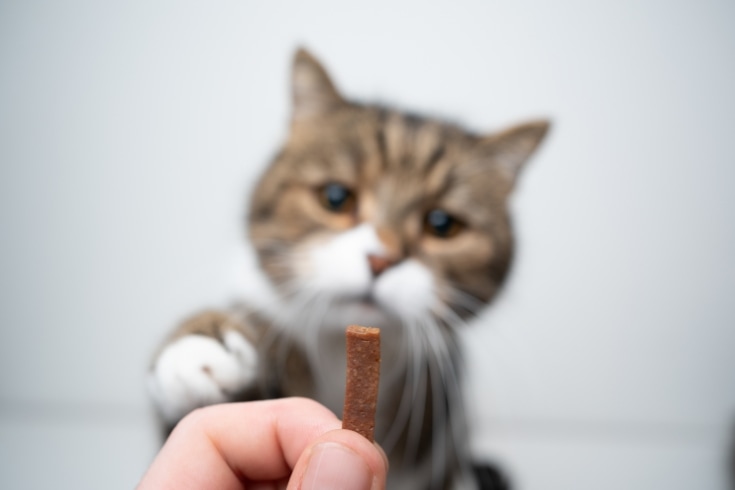
Lure training for cats is a form of positive reinforcement training that uses a lure, such as one of your cat’s favorite toys or treats, to encourage your cat to perform particular tricks or modify certain behaviors.
This form of training provides your furry friend with mental stimulation to prevent boredom and encourages physical exercise, helping to keep your precious pet fit and healthy.
How Does Cat Lure Training Work?
Lure training relies on using an attractive and motivational object to the cat, such as a treat or a toy, to move the cat into a desired position, such as a “sit,” or to move onto a certain spot like a bed or mat.
This form of training typically includes the use of a marker, such as a click or a word, to tell the cat she has performed the desired behavior. The marker is then followed up immediately with a treat.
For example, you might use a word such as “good” when the cat’s head follows your lure, and her rear end starts to drop into what eventually becomes a sitting position.
What Are The Benefits Of Lure Training Your Cat?
Lure training for cats can have many benefits. This training method is easy for pet owners and their cats to pick up and learn, and lure training can produce an almost immediate response for a cat that’s highly motivated by a special toy or delicious treat.
There are other benefits to lure training your cat with, which are overviewed below.
Mental Stimulation
Lure training can help to engage your cat’s mind and provide her with plenty of mental stimulation, which helps to keep boredom at bay. That’s essential for young indoor cats that can become destructive if they get bored while you’re not around to supervise.
Physical Exercise
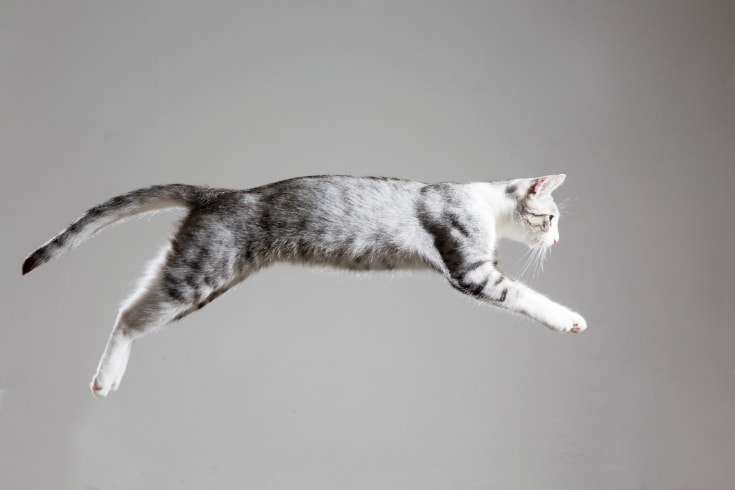
Lure training involves your cat moving around as part of her training program, helping to provide your pet with a fun and exciting way to burn off her excess energy and keep active.
Check out this cool video of a cat learning to jump through her owner’s arms by following a treat lure.
Bonding And Interaction
Using lure training helps to strengthen the bond between you and your pampered pet because you are working together in a positive and rewarding environment and having fun at the same time.
Enrichment And Confidence
Many cats find learning new behaviors and tricks thoroughly enjoyable and confidence-boosting, which contributes massively to your cat’s overall well-being.
For example, I once took on a senior cat from a shelter who was incredibly shy and nervous around people, including me. I started using lure training to teach my cat simple tricks, such as spinning around and sitting down, and her confidence improved in leaps and bounds as a result.
Improved Behavior And Obedience
Lure training uses positive reinforcement to show your cat that demonstrating a desired behavior or performing a trick gets her a tasty treat. Most cats that are suitably motivated by this training method quickly show improved behavior and become more obedient to basic commands and simple tricks.
Reducing Stress And Anxiety
Any cat training session can be a wonderful stress relieving tool, provided you use positive reinforcement rather than punishment to achieve the desired behavior you want. Essentially, you can use lure training to distract the cat so that she refocusses on an enjoyable and fun activity that can help reduce anxiety and stress.
What Are The Things You’ll Need For Lure Cat Training?
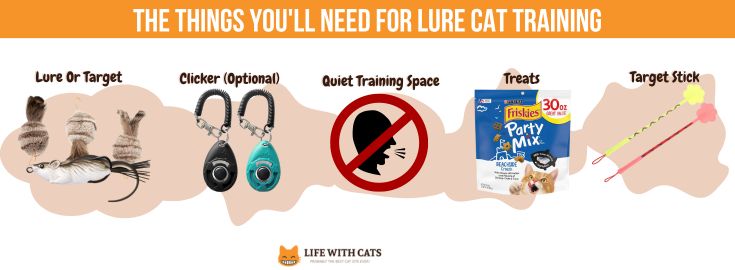
The things you’ll need for lure cat training are something to use as a lure, such as treats or a toy, a target stick to direct your cat’s attention, a clicker device if you want to use one, and somewhere peaceful and quiet where you can hold your training sessions without being interrupted or disturbed.
Lure Or Target
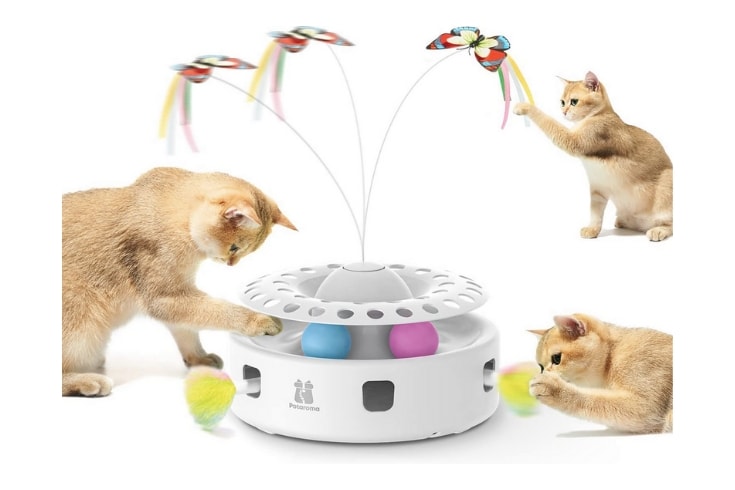
To grab your cat’s attention during lure training sessions, you need something she wants, such as some tasty treats or a favorite toy. Be sure to choose a lure that really motivates your cat to follow it; otherwise, your training might not be successful.
Treats

If you want to use a toy as a lure for your cat, you’ll also need some treats to reward your pet. Of course, if you’re already using treats as the lure, be careful not to overdo treating your kitty or you could end up with a well-trained but overweight feline!
Target Stick
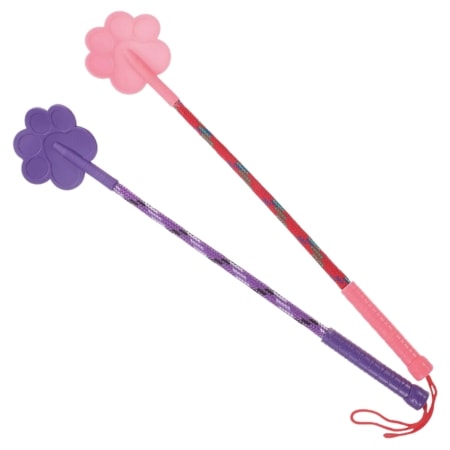
A target stick is a short wand with a ball fixed to one end that’s used to direct your cat’s attention to a particular place or object. Most cats willingly follow a target stick, but you can try rubbing a treat on the ball if your cat is reluctant.
Clicker (Optional)
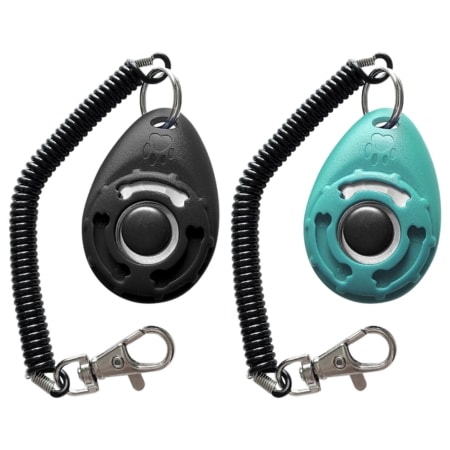
A clicker is a small, handheld device that you press to create a clicking sound. When training your cat, use the clicker immediately after your cat exhibits the desired behavior, and reward her with a treat. That way, the cat learns that the behavior is associated with a click, immediately followed by something pleasant, making it more likely that she will repeat the behavior in the future.
Quiet Training Space
Cats can be quite easily distracted, which is frustrating when you’re trying to train your pet to do something. So, before you start your training program, set aside a quiet, comfortable area in your home where you know you won’t be disturbed or interrupted.
It’s also a good idea to put your mobile phone on silent and ask family members not to interrupt you while you’re training your cat.
How Do You Lure-Train A Cat
To lure-train a cat, you’ll need to work through several stages.
First of all, you need to teach your cat to recognize the lure, which is usually pretty straightforward if you’re using your pet’s favorite treats.
Once the cat acknowledges the presence of the lure, you can use it to teach her some tricks or basic commands, such as sitting down or moving to a particular spot in the room. The final stage of lure training is fading the lure, in other words, gradually phasing out its use until the cat performs the trick without the lure being used.
Teaching Your Cat To Acknowledge The Lure
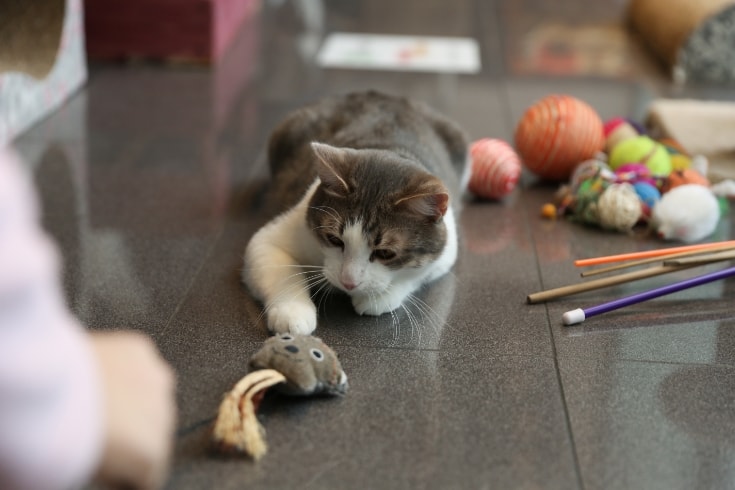
To begin with, you need to get your cat to acknowledge the lure. In my experience, that’s pretty straightforward if you have a cat that’s food oriented and wants the treats you’re using as a lure.
Step-by-step Guide
- Show your cat the lure you’ve chosen.
- Immediately reward your cat when she approaches the lure so that she associates it with something pleasant and is more likely to repeat the behavior
- The kitty will quickly know that touching the lure gets her a reward, and she’ll readily acknowledge the lure.
Using The Lure To Teach Tricks
Once your cat consistently acknowledges your lure, you can use that to train your pet in various behaviors and tricks. That works by using the lure to direct your cat to a different place or to encourage her to change her body position, such as sitting down.
Step-by-step Guide
- To teach your cat to lie down, have her sit and slowly bring the lure to the ground in front of your pet.
- That triggers the cat’s natural response to lie down and stretch out.
- Be sure to reward your cat immediately with the clicker, if you’re using one, and a treat.
- Throughout your training program, decide on cue words for each trick or behavior you want your cat to perform and use them consistently.
- Eventually, your cat will associate the word with the behavior, which is essential for the next phase of lure training.
Fading The Lure
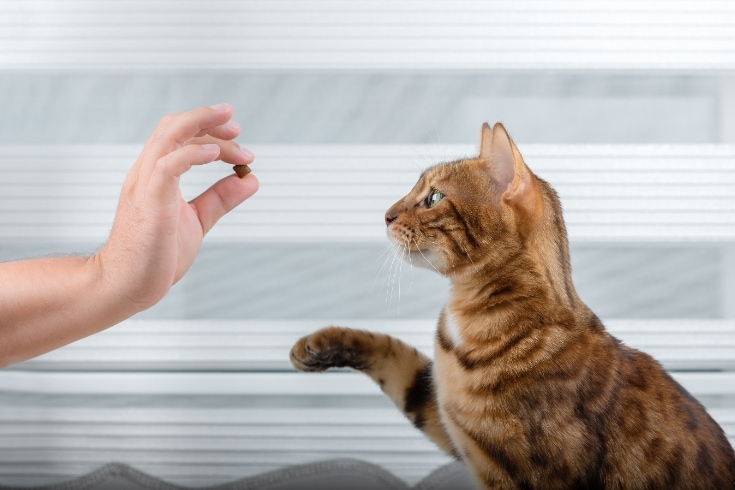
The final lure training stage involves weaning your cat off the lure by gradually fading it out. So, instead of using the lure every time you give your cat the verbal cue to perform a trick or behavior, sometimes just use positive reinforcement to reward your cat when she does the right thing.
Step-by-step Guide
- Don’t use the lure every time you ask your cat to perform a trick. Instead, use your verbal command, remembering to reward your cat with a treat.
- Use the lure less and less until you don’t need to use it all because the cat will perform the desired behavior from your verbal cue alone.
- Continue rewarding your cat with treats and praise every time you ask her to perform the desired behavior or trick.
What Are Some Expert Tips For Cat Lure Training?
Here are some tips for cat lure training that you might find helpful.
Start With Short Sessions
Cats have a relatively shorter tension span and can be easily distracted, so start with short training sessions and allow your cats plenty of breaks for playtime.
Don’t be tempted to keep pushing ahead when things are not going well, as that just leads to frustration for both you and your cat, and your pet could even become resistant to your lure training.
Gradual Introduction
Take your time when introducing lure training for your cat so that she can get used to the new training method without becoming frightened or stressed.
Be Patient And Positive
Throughout your lure training sessions, be patient and allow your cat plenty of time to understand what you want her to do.
Always use positive reinforcement methods so that the cat learns to associate desirable behaviors with an immediate reward, making her more likely to repeat those behaviors in the future.
Progress At Your Cat’s Pace
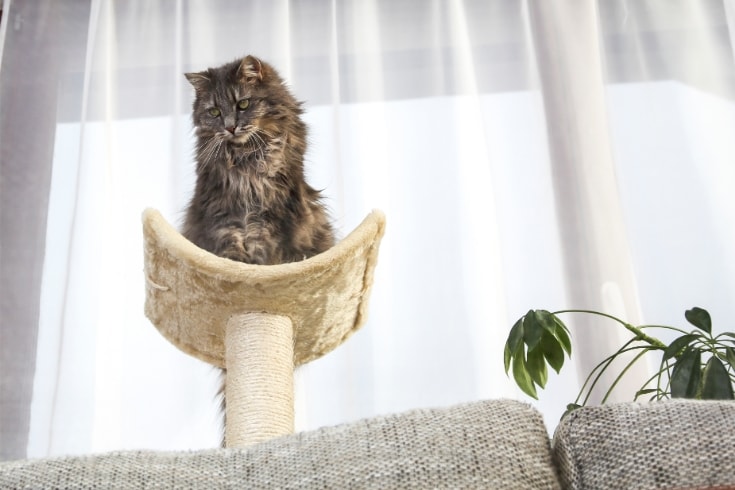
All cats are different, and some learn more quickly than others. Kittens and young adult cats tend to be quick learners, whereas senior felines might not be quite as quick to catch on to what you want, especially if you are demanding a radical behavioral modification from your pet.
Be ready and content to progress at your cat’s pace to keep training sessions fun for both of you and never be afraid to take a few steps back if you think your cat doesn’t understand what you are asking of her.
Vary The Movements
Cats are intelligent animals and can get bored if you keep repeating the same lesson repeatedly. Be ready to vary your cat’s lessons to keep her interested and motivated, and you will be more likely to succeed!
End On A Positive Note
No one likes to end a training session on a downer! So, if your cat struggles to grasp a new trick or modified behavior, always be ready to go back to something your cat is confident and comfortable performing so that every training session ends on a positive note.
Practice Consistency
Consistency is crucial when training your cat, so be sure to use the same cues and commands throughout your training sessions to avoid confusing your pet.
In addition, make sure that your family knows what cues your cat understands and uses them, too. That way, everybody, including your pet, sings from the same hymn sheet, making your training efforts more likely to succeed.
Conclusion
Lure training is an excellent way of using positive reinforcement to teach your cat to perform tricks and exhibit desired behaviors while providing your pet with mental stimulation and physical exercise.
This training technique is simple for you and your pet to learn and doesn’t need any fancy, expensive equipment. The lure can be a toy, a target stick, or some treats, and if you want to, you can use a clicker device, too. Once your cat understands the lure training method, you can gradually phase it out so that your pet responds solely to your vocal cues.
Cats of all ages can benefit from lure training, so why not check out our helpful tips and try lure training with your cat?